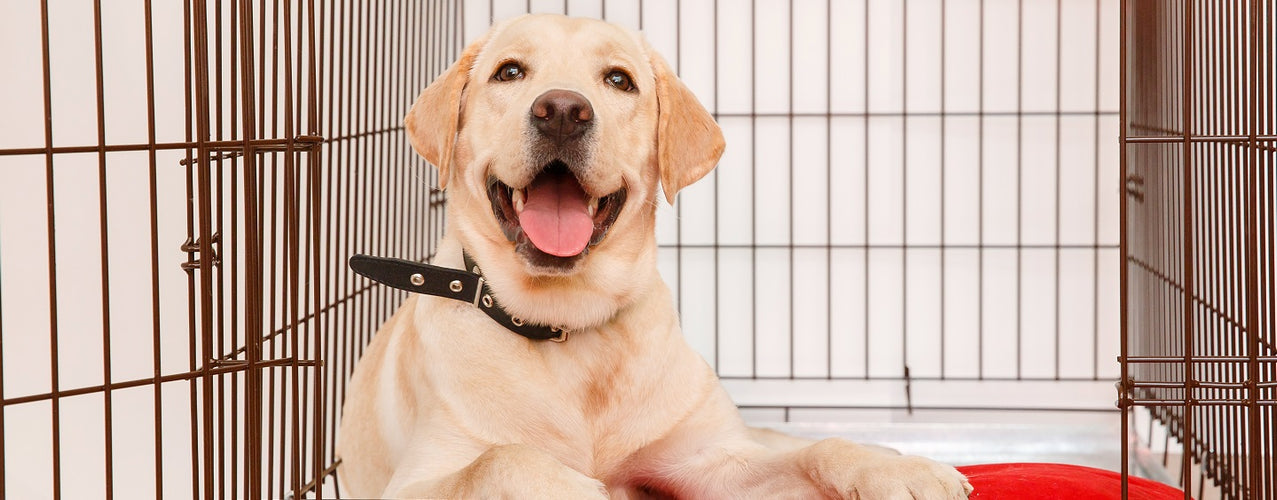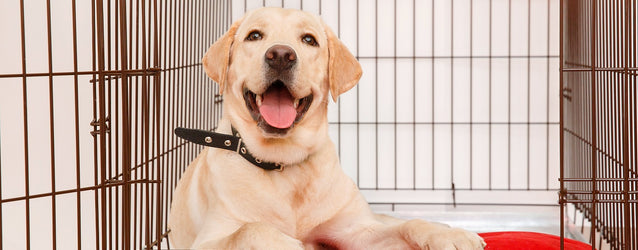

Posted by Emma Oldroyd, on
Dog Crate Training Tips from Pets & Friends
A dog crate is a fantastic tool for taking care of your pet, whether it’s providing them with a safe space within your home or keeping them secure on your travels- dog crates are a sturdy option for all breeds and sizes.
Crate training can be done at any age, but it’s always a good idea to start crate training from their early years, particularly if you’re using the crate around your home. We’ve put together a quick guide on how to help crate train your dog, including how you should approach the crate and when to make the next steps.
Before you start crate training, it’s important to remember that your dog’s crate is a safe haven- not the naughty step. Crates must never be used as punishment, or to prevent unwanted behaviours. Your dog’s crate should always be associated with something positive and remember to be patient- training can take place in phases, so don’t try to rush your dog through the process.

Choosing the Right Crate
The right crate all depends on the size of your dog. As a minimum, your dog’s crate needs to be big enough for them to sit and stand at their full height in, as well as stretch out, lie down in a natural position, and turn around comfortably.
Whilst it can be tempting to invest in a crate that will be big enough for your dog once they become an adult, if their crate is too large, some puppies can be overwhelmed by a vast space. It’s also important that your puppy doesn’t travel in an adult-sized crate as they won’t be secure enough on the journey.
For more information about setting up your dog crate, read our full Dog Crate Setup Guide over on the blog.
Step One: Introduction to the Crate
This first step is all about your dog getting used to their new surroundings. Initially, it’s a good idea to make sure the crate is in an area of your home where your family spends a lot of time, and your puppy or dog can be surrounded by noise.
During these initial stages it’s also important to keep the door of the crate fixed open, so your dog or puppy cannot get unknowingly trapped inside.
The key here is to let your dog explore at their own leisure, place some of their favourite treats or a chew inside the crate to help them step inside. If they need a little encouragement at first, call them over to their crate using positive tones, or create a ‘treat/toy trail’ to lead them into the crate.
It’s important to continue to give treats inside the crate for the first few attempts, this will help with positive association and your dog will want to stay in the crate (rather than head straight back out to claim another treat!).
Patience is key during this first stage; the intro session should be short (approx. 5 mins) until your dog gets the hang of things and is comfortable exploring their crate. There is no set time it should take your dog to acclimatise, it can take anything from a few minutes to a few days.
What if my puppy falls asleep elsewhere?
If your puppy falls asleep either on you or in another part of the house, gently place them in their crate as they sleep, so they wake up in their safe space.
Step Two: Increasing Their Time in the Crate
To help your dog spend longer in their crate, try feeding them meals within the crate. You can start by placing their food bowl in the back of the crate, so they walk all the way in to eat.
If your dog is more reluctant to enter the crate, or eat in there, take a step back and place their food just outside of the open crate door and slowing moving it further into the crate at each mealtime.
If your dog is happy to enter and eat their dinner in the crate, you can try closing the door. You should open the door as soon as they have finished their meal. As step two progresses, keep the door closed a little longer each time, so eventually your dog can comfortably stay in the closed crate for 10-15 minutes after eating.
If your dog begins to show any signs of distress when their crate door is closed (whining, panting, cowering, barking or aggression) always take a step back and open the crate door to ensure your dog is comfortable.
By the end of step two- your dog should understand that their crate is their safe space.

Step Three: Leaving Them Alone in the Crate
As your dog’s confidence grows inside their create with the door closed, you should be able to gradually start to leave them alone for short periods of time.
Remember, positive reinforcement is key- during step three remember to keep their favourite toy or treat at the back of their create. Slow feeders or feeding puzzles are also a great way to keep your dog entertained during their crate time whilst you’re away.
When it comes to leaving your dog, start slowly. Once their crate door is shut, stay close (but quiet) for approx. 5 minutes after the door has been closed. By this time, they should be more interested in the contents of their crate than your whereabouts.
Once the 5 minutes is up, you can slowly and calmly leave the room so you’re out of sight. Then go straight back into the room and open the crate door.
Repeat this process, but each time you leave the room, do it for slightly longer each time until you reach 30 minutes. Once you have successfully reached 30 minutes out of sight, you can repeat the leaving process throughout the day. We would recommend trying it at different times of day so that your dog is aware it can happen at any time, rather than on a schedule.
For this step, always make sure your dog has a safe occupier chew or toy during their time alone in the crate. If your dog gets bored this can lead to whining or barking (remember, never open the door in a reaction to your dog being vocal as this will teach them that noise gets them what they want!).
Step Four: Heading Out
Now your dog can be left for 30 minutes at a time without showing any signs of distress, step 4 is all about moving on and leaving them for short periods of time.
To prepare your dog for being left alone in their crate, the following steps are crucial:
- Always feed your dog before you leave them
- Always ensure your dog has been to the toilet before you leave them
- Always exercise your dog before leaving them
These steps will ensure that your dog will be more likely to relax/occupy themselves whilst they are left alone.
When leaving your dog to go out, don’t make a fuss about ‘goodbye’; instead, praise them and thank them for going to their crate. The same goes for when you return, reiterate the positive message about them staying in their create.
Remember, adult dogs should not be left alone in their crate for more than 4 hours and puppies shouldn’t be left for over an hour.
If you’re looking for the right dog crate, or more help with crate training, you can head down to your nearest Pets & Friends where our experts are on hand with advice, tips and their tape measure!